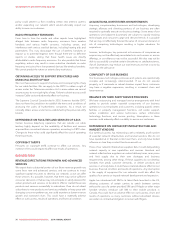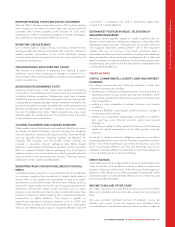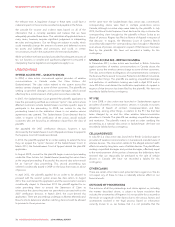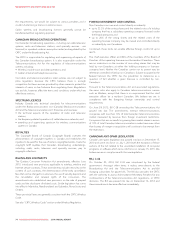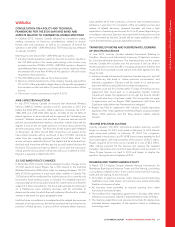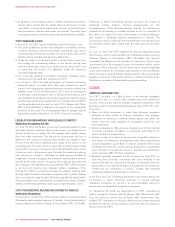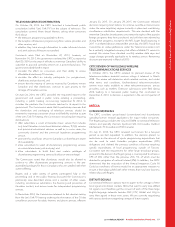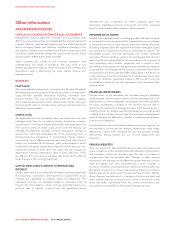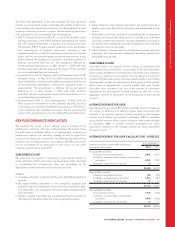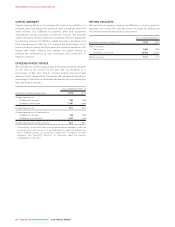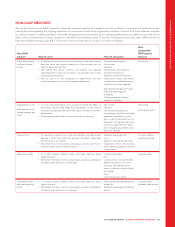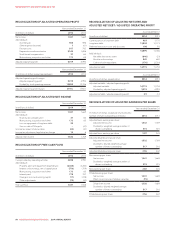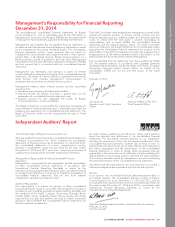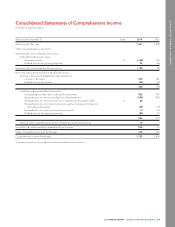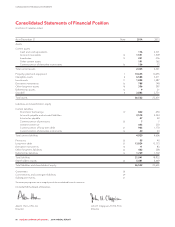Rogers 2014 Annual Report Download - page 84
Download and view the complete annual report
Please find page 84 of the 2014 Rogers annual report below. You can navigate through the pages in the report by either clicking on the pages listed below, or by using the keyword search tool below to find specific information within the annual report.
MANAGEMENT’S DISCUSSION AND ANALYSIS
tax, our business is complex and significant judgement is required in
interpreting how tax legislation and regulations apply to us. Our tax
filings are subject to audit by the relevant government revenue
authorities and the results of the government audit could materially
change the amount of our actual income tax expense, income taxes
payable or receivable, other taxes payable or receivable and deferred
income tax assets and liabilities and could, in certain circumstances,
result in the assessment of interest and penalties.
CONTINGENCIES
Considerable judgement is involved in the determination of
contingent liabilities. Our judgement is based on information currently
known to us, and the probability of the ultimate resolution of the
contingencies. If it becomes probable that a contingent liability will
result in an outflow of economic resources, we will record a provision in
the period the change in probability occurs. The amount of the loss
involves judgement based on information available at that time. Any
provision recognized for a contingent liability could be material to our
consolidated financial position and results of operations.
TRANSACTIONS WITH RELATED PARTIES
We have entered into certain transactions in the normal course of
business with related parties in which we have an equity interest. The
amountspaidtothesepartieswereasfollows:
Years ended December 31
(In millions of dollars) 2014 2013 % Chg
Revenues 15 3n/m
Purchases 88 83 6
n/m: not meaningful.
We have entered into certain transactions with companies, the partners
or senior officers of which are Directors of Rogers and/or our subsidiary
companies.Totalamountspaidtotheserelatedparties,directlyor
indirectly, were as follows:
Years ended December 31
(In millions of dollars) 2014 2013 % Chg
Printing, legal services and commission paid on
premiums for insurance coverage 38 43 (12)
We have entered into certain transactions with our controlling
shareholder and companies it controls. These transactions are subject
to formal agreements approved by the Audit Committee. Total
amounts paid to these related parties generally reflect the charges to
Rogers for occasional business use of aircraft, net of other
administrative services, and were less than $1 million for 2014 and
2013 combined.
These transactions are measured at the amount agreed to by the
related parties, which are also reviewed by the Audit Committee. The
amounts owing are unsecured, interest-free and due for payment in
cash within one month from the date of the transaction.
NEW ACCOUNTING STANDARDS
We adopted the following new accounting standards effective
January 1, 2014.
• Amendments to IAS 32, Financial Instruments: Presentation
(IAS 32) – In December 2011, the IASB amended IAS 32 to clarify the
meaning of when an entity has a current legally enforceable right of
set-off.
• Amendments to IAS 39, Financial Instruments: Recognition and
Measurement (IAS 39) – In June 2013, the IASB amended IAS 39 to
provide relief from discontinuing an existing hedging relationship
when a novation that was not contemplated in the original hedging
documentation meets specific criteria.
• IFRIC 21, Levies (IFRIC 21) – In May 2013, the IASB issued IFRIC 21,
which provides guidance on when to recognize a liability for a levy
imposed by a government, both for levies that are accounted for in
accordance with IAS 37, Provisions, Contingent Liabilities and
Contingent Assets and those where the timing and amount of the
levy is certain. The Interpretation identifies the obligating event for
the recognition of a liability as the activity that triggers the payment
of the levy in accordance with the relevant legislation. It provides the
following guidance on recognition of a liability to pay levies (i) the
liability is recognized progressively if the obligating event occurs
over a period of time, and (ii) if an obligation is triggered on
reaching a minimum threshold, the liability is recognized when that
minimum threshold is reached.
The accounting pronouncements we adopted in 2014 were made in
accordance with their transitional provisions, which were required to
be applied retrospectively and had no impact on our financial results.
RECENT ACCOUNTING PRONOUNCEMENTS
We are required to adopt the following revised accounting standards
on or after January 1, 2015. We are assessing the impact of adopting
these revised standards on our 2015 interim and consolidated financial
statements.
• IFRS 15, Revenue from Contracts with Customers (IFRS 15) - In May
2014, the IASB issued IFRS 15 which supersedes existing standards
and interpretations including IAS 18, Revenue and IFRIC 13,
Customer Loyalty Programmes. The standard is effective for annual
periods beginning on or after January 1, 2017.
IFRS 15 introduces a single model for recognizing revenue from
contracts with customers with the exception of certain contracts under
other IFRSs such as IAS 17, Leases. The standard requires revenue to
be recognized in a manner that depicts the transfer of promised goods
or services to a customer and at an amount that reflects the expected
consideration receivable in exchange for transferring those goods or
services. This is achieved by applying the following five steps:
1. Identify the contract with a customer;
2. Identify the performance obligations in the contract;
3. Determine the transaction price;
4. Allocate the transaction price to the performance obligations in
the contract; and
5. Recognize revenue when (or as) the entity satisfies a performance
obligation.
IFRS 15 also provides guidance relating to the treatment of contract
acquisition and contract fulfillment costs.
80 ROGERS COMMUNICATIONS INC. 2014 ANNUAL REPORT


